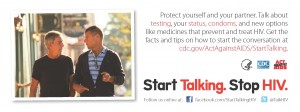Key Conversations in 2014: HIV Prevention
Topics

Today, we highlight some of our most-accessed blog posts focusing on key developments in HIV prevention.

HIV Testing. With efforts to improve outcomes along the HIV care continuum in even sharper focus throughout 2014, many partners in the HIV community worked to help identify more of the nearly 1 in 6 Americans who have HIV but do not know they are infected. Without knowledge of their HIV status, they are unable to take advantage of treatment that will allow them to stay healthy and reduce the risk of transmitting the infection to their partners. Fortunately, as then-Assistant Secretary for Health Howard Koh shared on National HIV Testing Day in June, getting an HIV test has become easier thanks to the Affordable Care Act (ACA), which requires most new health insurance plans to cover certain preventive services—including HIV testing—without additional costs (e.g. co-pays or deductibles) to the consumer. Also as we reported in June, several national partners have stepped up to promote HIV testing, including Greater Than AIDS and Walgreens, which teamed up with nearly 200 state and local health departments and AIDS service organizations to provide free HIV testing at Walgreens locations in 33 states and more than 140 cities nationwide.
PrEP Deployment. The implementation of pre-exposure prophylaxis (PrEP) as a promising tool to prevent the transmission of HIV continued to be a significant part of the HIV conversation in 2014. Intended for populations at substantial risk of becoming infected with HIV, PrEP is a relatively new prevention strategy that includes daily medication and routine follow-up. Among our most-accessed stories was an announcement from CDC about the release of new guidelines for the use of daily oral PrEP to prevent HIV infection. The much-anticipated guidelines provide health care providers with recommendations on the use of PrEP, replacing previous interim guidance from CDC. CDC also hosted a Public Health Grand Rounds in May 2014, which generated a great deal of interest. The Grand Rounds featured HIV experts discussing the recently-published guidelines and challenges to effective implementation that must be addressed to make PrEP a success. In October 2014, we featured a report on the launch of PrEPline, a telephone consultation service to provide free, expert advice to U.S.-based clinicians seeking to prescribe PrEP to their patients. This service helps advance the National HIV/AIDS Strategy’s first goal of reducing new HIV infections by making state-of-the-art information and consultation on prevention available to providers across the country.
Addressing the Intersection Between HIV/AIDS and Violence Against Women and Girls. Women and girls continue to be all too frequently victimized by domestic violence and sexual assault, which can put them at greater risk for acquiring HIV and inhibit them from seeking prevention, treatment, and health services. As we reported on our blog, the U.S. government engaged in several efforts in 2014 to prevent and reduce violence against women at risk for and living with HIV. These included the release of an update from the Working Group on the Intersection of HIV/AIDS, Violence Against Women and Girls, and Gender-related Health Disparities , outlining dozens of cross-agency advances that have occurred over the past year, as well as the announcement of a joint effort between the U.S. Department of Justice (DOJ) and the U.S. Department of Housing and Urban Development’s (HUD) Housing Opportunities for People with AIDS (HOPWA) program to allocate funding and resources to support transitional housing for women living with HIV who are experiencing violence in their lives. Also, as we shared in October, the Kaiser Family Foundation released HIV, Intimate Partner Violence (IPV) and Women: New Opportunities Under the Affordable Care Act, an important analysis of the law’s broad changes expanding access to affordable health coverage, and its specific provisions designed to protect individuals who have experienced IPV.
These posts about HIV prevention can inform your local conversations, events, and actions on or around World AIDS Day as you promote this year’s theme, “Focus, Partner, Achieve: An AIDS-free Generation.” We look forward to reporting on more new developments in the HIV arena in 2015 as domestic and global partners continue their outstanding efforts to bring an end to HIV both here and around the world.